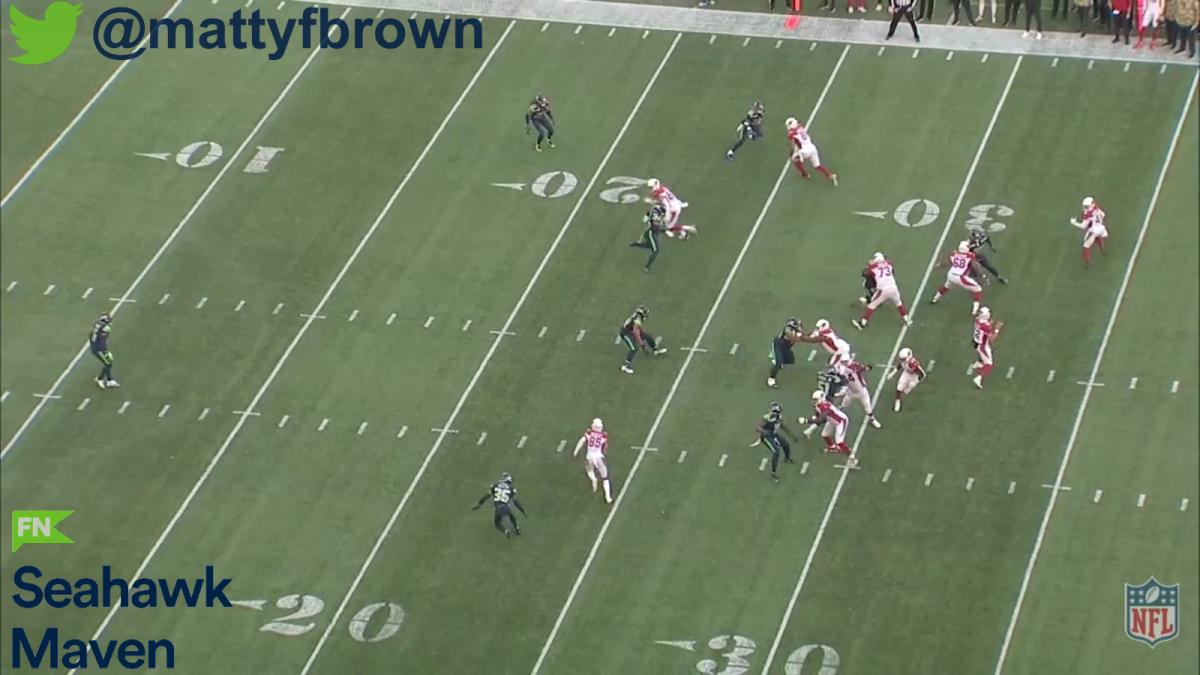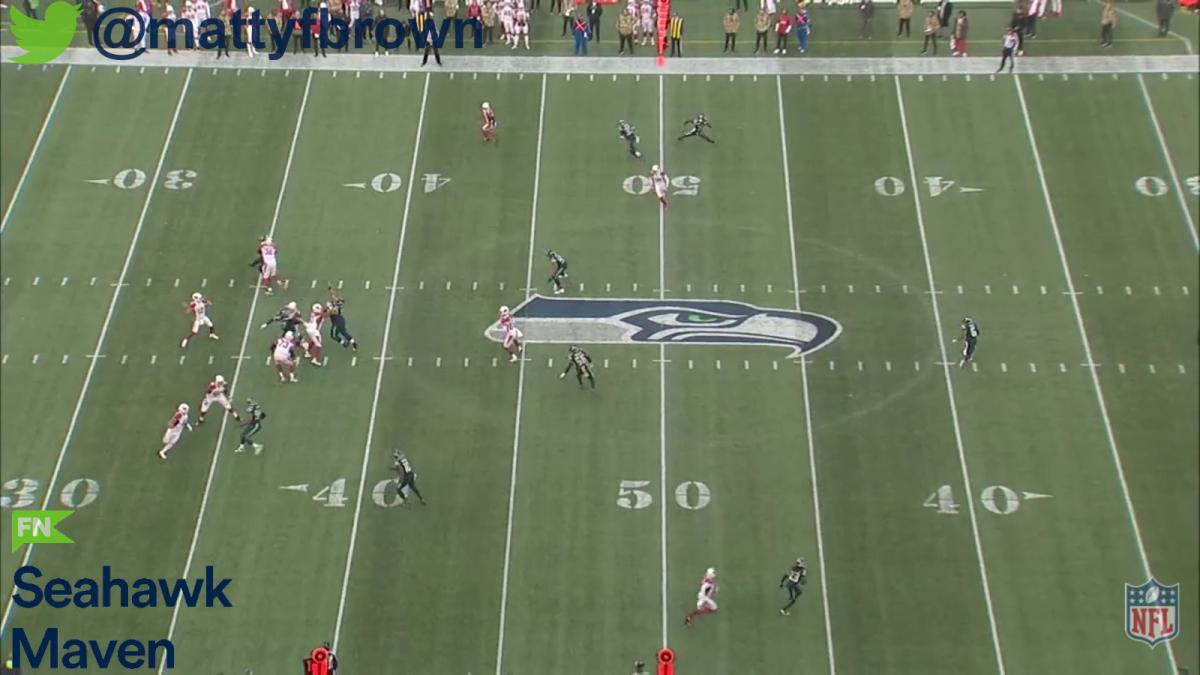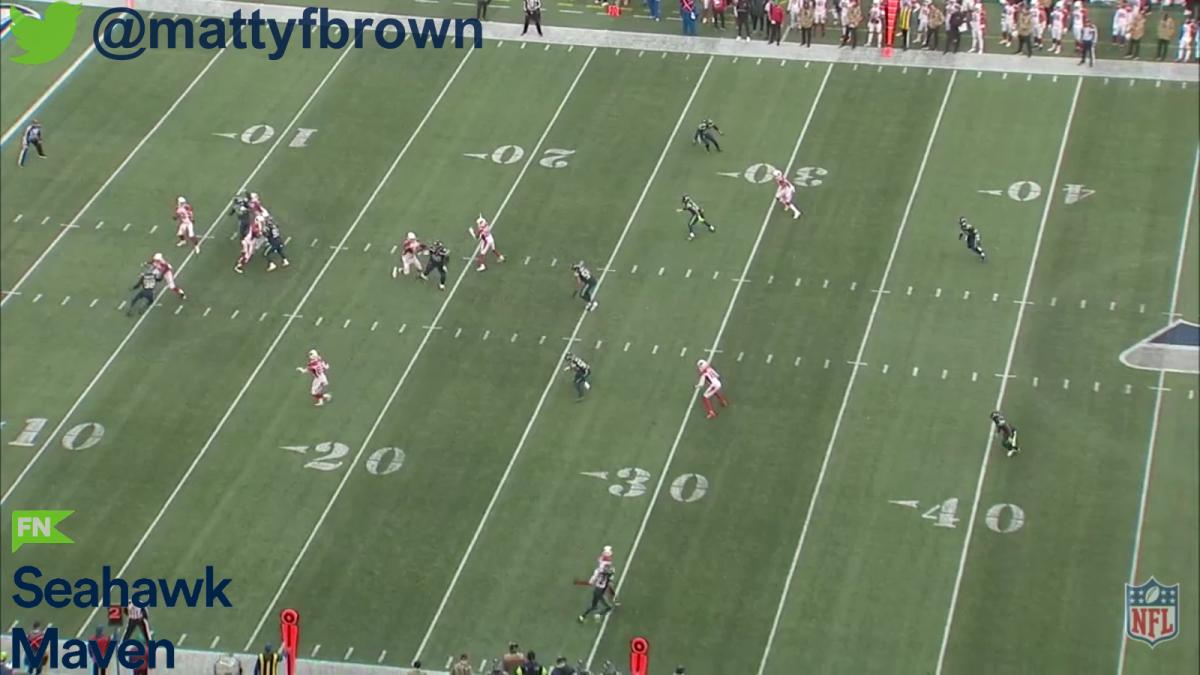Don’t Take the Cheese: Seahawks Zone Coverage Exhibits Ill-Discipline vs. Cardinals
The Seahawks' defense was supposed to have turned a corner. After an impressive display in testing circumstances versus the Packers, the Kyler Murray-less Cardinals should have been easy work for Ken Norton Jr.’s unit. Instead, Seattle’s defense allowed seven explosive passing plays from backup quarterback Colt McCoy.
The Seattle #Seahawks defense allowed 7 explosives vs. the Arizona Cardinals in Week 11:
— Under Zone X (Frisco)/Phoenix Check/Stick Slasher2 (@mattyfbrown) November 22, 2021
1) 10.23 1st QTR James Conner 17-yard catch
2) 7.37 2nd QTR A.J. Green 31-yard catch
3) 2.30 2nd QTR Zach Ertz 25-yard catch
4) 0.57 2nd QTR Antoine Wesley 20-yard catch
5) 15.00 3rd QTR Green 21-yard catch
— Under Zone X (Frisco)/Phoenix Check/Stick Slasher2 (@mattyfbrown) November 22, 2021
6) 5.47 3rd QTR Green 16-yard catch
7) 4.14 4th QTR Ertz 20-yard catch
Colt McCoy relied on quick passes and play action in the #Cardinals 23-13 victory over the Seahawks.
— Next Gen Stats (@NextGenStats) November 22, 2021
Play Action
🔹 33% of dropbacks
🔹 13/14, 132 yards, TD (+19.4% CPOE)
Quick Passes (< 2.5 seconds)
🔹 73% of attempts
🔹 25/32, 201 yards, 2 TD#ARZvsSEA | #RedSea pic.twitter.com/6Mc0NIY7if
This was thanks to a combination of four major factors.
Firstly, McCoy played out of his mind. It was a get-paid performance from the 35-year old veteran, looking defenders off, quick releasing and finding the right pressure beaters. Even after the Seahawks started executing better, McCoy found ways to extend plays.
Secondly, Arizona head coach Kliff Kingsbury called a terrific game, finding various ways to put four eligible receivers to one side and therefore punish Seattle’s cover 3.
Thirdly, the Seahawks entered the game without their best cornerback in D.J. Reed and also lost their other starter, Tre Brown, early.
Finally, and most damning, Seattle’s pass defense melted down execution-wise. There were some amateur flat-out busts, like lacking a wall No. 2 player on a two-deep, four-under fire zone and playing Tampa 2 invert with two players rotating into the same deep half zone on the field. There were defenders clumsily running into each other. And they also failed in their basic cover 3 execution, taking the "cheese" in coverage. It’s this fromage nibbling we are going to explore.
The idea of Seattle’s pattern matching cover 3 is that, for the vast majority of situations, the four underneath zone defenders will drop to their landmarks (ball in middle of field: hook defenders 10-12 yards back, one yard inside hash; buzz defenders 8-10 yards back, to and through the numbers) and not cover routes with a depth of five yards or under.
Instead, the Seahawks defenders will wait in their landmarks visioning the quarterback and break on the ball, swarming to the checkdown catch and making the tackle to limit the gain. A smart assumption is that when a defender sees a route in front of them in their no cover zone, there is likely to be a deeper route behind them.
Offenses, of course, are aware of this visioning-from-depth tactic and they attempt to stress the underneath zone defenders by placing eye candy in front of them—or "cheese." Great discipline is required of the zone defenders to not bite on this cheese.
Bobby Wagner, when asked Wednesday if the Washington Football Team would attempt a copycat of the Cardinals’ short middle concepts, replied with a cheese mention.
“I expect them to kind of do the same thing, but it’s also in their gameplan naturally,” the middle linebacker began. “I think what they do is they run a lot of cheese concepts, and we call it cheese concepts. They put something in front of you to make you eat it and throw something behind you. So they run a lot of those, so they’re gonna have those.”
Three of Arizona’s seven explosive plays came via their mouse traps.
With two minutes 30 seconds left in the second quarter on 2nd and 3, Jordyn Brooks took the cheese. The pre-snap shift of this play may have messed the linebacker up. With a 2x2 distribution in cover 3, down safety Jamal Adams would have been expected to carry a second seam route to his side deep and Brooks, the hook defender, would have been alert to the flat route checkdown with Adams no longer there thanks to his matching assignment. The Seahawks may also have been in a cover 2 defense to this formation.
However, following the jet motion and the creation of four threats to one side, Seattle played cover 3 sky. Adams correctly flooded his coverage to the four threats, going through the numbers and waiting for the checkdown. The stress was on Brooks in the strong hook to get depth with the No. 2 receiver, tight end Zach Ertz, after the linebacker had identified pass. Brooks bit on the pump fake of McCoy, pausing to rally to the route that Adams already had covered. With the defender taught to read the shoulders of the quarterback and McCoy hard selling it, this was tough.
The Seahawks have found schematic ways to place Brooks’ speed in the weak hook of cover 3 and keep Wagner in the strong hook, sometimes putting Brooks technically at the “MIKE” spot in the defense and Wagner at “WILL.” One consequence of this is that Brooks has experienced a lot less exposure to the strong hook issues teams throw at the assignment.

Brooks’ pause left space for McCoy to throw the 25-yard pass behind and inside of the linebacker. The completion was shallow enough to be away from the midpointing deep 1/3 of left cornerback Sidney Jones. With the free safety in the defense assigned a ‘no seams, no posts’ mantra, it is somewhat surprising Quandre Diggs did not adjust his post 1/3 play to lean to the four threats. Yet, Diggs was surely influenced by the pre-motion picture and also the final formation being into the boundary—meaning a route was more likely to travel back across the field.
— Ultra Rare Tape (@UltraRareTape) November 24, 2021
Brooks was far away from the A.J. Green 21-yard completion to open the second half. Still, he could have done better. Brooks was in the weak hook—an assignment he is more familiar with—and therefore needed to get more depth and vision across the field once he saw his No. 2 receiver break inwards towards Wagner. Instead, Brooks was happy coming down on the tight end. Wagner in the strong hook could also have gained more depth in his drop immediately following the play fake.

A separate issue was Jamal Adams trying to do too much as a buzz defender, where his holding of depth to account for a potential wheel route and also help versus the No. 1 receiver ended up impeding cornerback Blessuan Austin’s break on the eventual Green in-cut.
— Ultra Rare Tape (@UltraRareTape) November 24, 2021
To end, we have a frustrating 2nd and 15 completion to Green that picked up a new set of downs. Seattle adjusted to Kingsbury’s cover 3 beaters in the second half via more middle field open coverage concepts—the stuff that had been proving successful up until this game.
On this Green 16-yard catch with 5:47 remaining in the third quarter, the Seahawks played a quarter-quarter-half, cover 6 to the four receiving threats.
In his quarter flat drop, Brooks dropped underneath the No. 2 receiver. Wagner also gained depth in his No. 3 receiver hook. However, Brooks—aware of the check-and-release of the No. 3 receiver into the flat—drifted outside and down, ready to get to the checkdown. Brooks instead should have let McCoy's shoulder and release take him there, if required. Brooks trying overly hard, along with Wagner drifting towards the middle and Diggs playing far off, left room for a stunning completion from McCoy.

In fairness to Seattle’s coverage, McCoy had almost four seconds to deliver this throw. Though he was hit shortly after his fast release, McCoy had serious time to wait for this play to progress. Coverage defenders expect the pass rush to force the ball to the underneath after a certain amount of time—which is absolutely reasonable nearing the four-second mark, play action or not.
— Ultra Rare Tape (@UltraRareTape) November 24, 2021
It's feasible and reasonable to expect the Seahawks defense to correct their errors from the Cardinals game—including the manner in which they took cheese. Meanwhile, Brooks will have learned some valuable lessons from his experience in less common assignments. The worrying element is that Seattle’s defense seems to slip back into these collective meltdowns after solid weeks of play. Norton's unit has shown us repeatedly that this is who they are.
